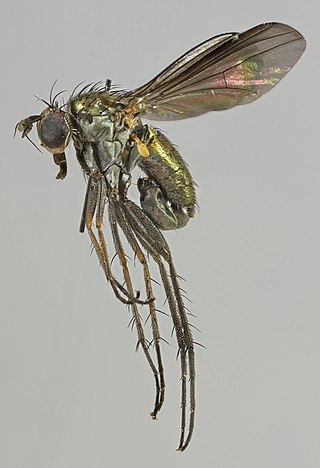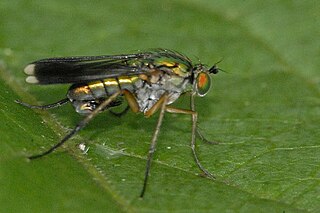
Hercostomus is a genus of flies in the family Dolichopodidae. It is a large genus, containing more than 483 species worldwide. Multiple studies have shown that Hercostomus is a polyphyletic assemblage of species.
Acropsilus is a genus of flies in the family Dolichopodidae. It is unplaced in the family, having been placed variously in subfamilies such as Sympycninae or Peloropeodinae. It is superficially similar to the Medeterinae.

Chrysosoma is a genus of flies in the family Dolichopodidae. It is a large genus, with more than 200 species distributed in the Old World and Oceania.

Diaphorus is a genus of flies in the family Dolichopodidae. Lyroneurus was formerly considered a subgenus, but is now either treated as a synonym of Chrysotus or treated as a distinct genus.

Medetera is a large genus of flies in the family Dolichopodidae. It includes about 350 species worldwide. The adults are commonly found resting on vertical surfaces such as tree trunks, on which they have a characteristic vertical upright stance. Because of this stance, they are sometimes known as "woodpecker flies". Medetera adults are predators of soft-bodied arthropods, while the larvae are predators of bark beetle larvae.
Mesorhaga is a genus of flies in the family Dolichopodidae.

Neurigona is a genus of flies in the family Dolichopodidae. It is a large genus, with over 150 known species.

Rhaphium is a genus of flies in the family Dolichopodidae. It is the largest genus within the subfamily Rhaphiinae, with over 200 species currently known.

Syntormon is a genus of flies in the family Dolichopodidae. It includes about 110 species worldwide, more than 50 of which were described from the Palaearctic realm.

Tachytrechus is a genus of long-legged flies in the family Dolichopodidae.

Teuchophorus is a genus of flies in the family Dolichopodidae.

Xanthochlorus is a genus of flies in the family Dolichopodidae. It is the only member of the subfamily Xanthochlorinae. In some classifications, the genus is included in the subfamily Sympycninae.

Dolichopodinae is a subfamily of flies in the family Dolichopodidae.

Peloropeodinae is a subfamily of flies in the family Dolichopodidae. In some classifications, the genera of the subfamily are included in Sympycninae. According to a molecular phylogenetic analysis of the family Dolichopodidae by Germann et al. (2011), the subfamily is polyphyletic.

Gymnopternus is a genus of flies in the family Dolichopodidae. It was formerly placed as a subgenus of Hercostomus, but is now accepted as a separate genus.

Poecilobothrus is a genus of flies in the family Dolichopodidae.
Setihercostomus is a genus of flies in the family Dolichopodidae, known from China, Taiwan, Russia and Tanzania.














